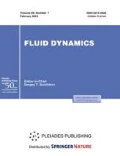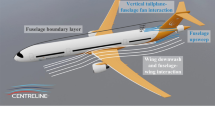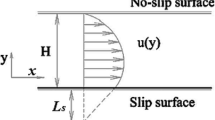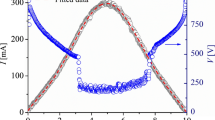Abstract—
The domain in the “total enthalpy–stagnation pressure” coordinates and, correspondingly, the ranges of the velocity and altitude of the atmospheric entry of a body with the nose bluntness radius of 1 m, for which the conditions of the local modeling of heat transfer to the stagnation point are fulfilled in subsonic high-enthalpy air jets flowing around cylindrical flat-nosed models, 20 to 140 mm in diameter, are established. The region of the trajectory of the European experimental IXV vehicle entry into the atmosphere, in which the local modeling of the convective heating of the vicinity of its nose, assuming 1 m in radius, is possible in the VGU-4 HF plasmatron, is determined.



Similar content being viewed by others
REFERENCES
A. F. Kolesnikov and M. I. Yakushin, “Determination of the effective probabilities of heterogeneous atom recombination from the heat fluxes to a surface in a dissociated-air flow,” Mat. Model 1(3), 44–60 (1989).
S. A. Vasil’evskii, A. F. Kolesnikov, and M. I. Yakushin, “Determination of the effective probabilities of the heterogeneous recombination of atoms, when heat flow is influenced by gas-phase reactions,” High Temperature 29(3), 411–419 (1991).
A. N. Gordeev, A. F. Kolesnikov, and M. I. Yakushin, “An induction plasma application to “Buran’s” heat protection tiles ground tests,” SAMPE J. 28(3), 27–31 (1992).
A. N. Gordeev and A. F. Kolesnikov, “Induction plasmatrons of VGU series,” in: Topical Problems of Mechanics, Physico-Chemical Mechanics of Liquids and Gases (Nauka, Moscow, 2010), pp. 151–177 [in Russian].
A. F. Kolesnikov, I. S. Pershin, S. A. Vasil’evskii, and M. I. Yakushin, “Study of quartz surface catalycity in dissociated carbon dioxide subsonic flows,” J. Spacecraft Rockets 37(5), 573–579 (2000).
A. F. Kolesnikov, A. N. Gordeev, and S. A. Vasil’evskii, “Effects of catalytic recombination on the surfaces of metals and quartz for the conditions of entry into the Martian atmosphere,” High Temperature 54(1), 29–37 (2016).
G. N. Zalogin, B. A. Zemlyanskii, V. B. Knot’ko, L. A. Kuz’min, V. V. Lunev, I. N. Murzinov, and A. N. Rumynskii, “High-frequency plasmatron–a setup for investigations of aerophysical problems using high-enthalpy gas flows,” Kosmonavtika Raketostroenie No. 2, 22–32 (1994).
V. I. Vlasov, G. N. Zalogin, B. A. Zemlyanskii, and V. B. Knot’ko, “Methods and results of an experimental investigation of the catalytic activity of materials at high temperatures,” Fluid Dynamics 38(5), 815–825 (2003).
B. E. Zhestkov, “Investigation of thermochemical stability of thermal protection materials,” TsAGI Sci. J. 45(8), 781–802 (2014).
B. Bottin, O. Chazot, M. Carbonaro, V. Van Der Haegen, and S. Paris, “The VKI plasmatron characteristics and performance,” in: Measurement Techniques for High Enthalpy and Plasma Flows, NATO-RTO-EN-8 (1999).
B. Bottin, M. Carbonaro, V. Van Der Haegen, and S. Paris, “Predicted and measured capability of the 1.2 MW plasmatron regarding re-entry simulation,” in: Proc. Third Europ. Symp. on Aerothermodynamics for Space Vehicles. ESTEC, Noordwijk, The Netherlands, November 24–26, 1998, ESA SP-426 (1999), pp. 553–560.
O. Chazot, H. V. Krassilchikoff, and J. Thomel, “TPS ground testing in plasma wind tunnel for catalytic properties determination,” AIAA Paper 2008-1252 (2008).
V. Auweter-Kurtz, H. L. Kurtz, and S. Laure, “Plasma generators for re-entry simulation,” J. Propulsion Power 12(6), 1053–1061 (1996).
G. Herdrich, M. Auweter-Kurtz, H. Kurtz, T. Laux, and M. Winter, “Operational behavior of inductively heated plasma source IPG-3 for entry simulations,” J. Thermophysics Heat Transfer 16(3), 440–449 (2002).
B. Massuti-Ballester, S. Pidan, G. Herdrich, and M. Fertig, “Recent catalysis measurements at IRS,” Adv. Space Res. 56(4), 742–765 (2015).
A. Bourdon, A. Bultel, A. Desportes, B. van Ootegem, and P. Vervisch, “Catalycity studies of TPS in a 90 kW plasmatron at CORIA,” Presented at the 2nd International Symposium “Atmospheric Reentry Vehicles and Systems,” Arcachon (France), March 26–29, 2001.
M. Dougherty, W. Owens, J. Meyers, and D. Fletcher, “Investigations of surface-catalyzed recombination reactions in Mars atmosphere,” In: 49th AIAA Aerospace Sciences Meeting Including the New Horizons Forum and Aerospace Exposition, January 4–7, 2011, Orlando, Florida.
D. G. Fletcher and J. M. Meyers, “Surface catalyzed reaction efficiencies in oxygen plasmas from laser induced fluorescence measurements,” J. Thermophysics Heat Transfer 31(2), 410–420 (2017).
A. F. Kolesnikov, “Conditions of simulation of stagnation point heat transfer from a high-enthalpy flow,” Fluid Dynamics 28(1), 131–137 (1993).
A. F. Kolesnikov, “Local similarity conditions of the thermochemical interaction between high-enthalpy gas flows and an undestructible surface,” High Temperature 52(1), 110–116 (2014).
A. F. Kolesnikov, A. N. Gordeev, and S. A. Vasil’evskii, “Modeling the stagnation point heating and determining the catalytic activity for the re-entry EXPERT vehicle,” in: Physico-Chemical Kinetics in Gasdynamics. Vol. 9 (2010); http://chemphys.edu.ru/issues/2010-9/articles/123/ [in Russian].
S. A. Vasil’evskii, A. N. Gordeev, and A. F. Kolesnikov, “Local modeling of the aerodynamic heating to the blunt body surface in subsonic high-enthalpy flow. Theory and experiment on high-frequency plasmatron,” Fluid Dynamics 52(1), 158–164 (2017).
A. F. Kolesnikov, A. N. Gordeev, S. A. Vasil’evskii, and E. S. Tepteeva, “The effect of the geometry of the discharge channel in a high-frequency plasmatron in high-enthalpy subsonic air jets,” High Temperature 57(4), 469–476 (2019).
S. A. Vasil’evskii, A. N. Gordeev, and A. F. Kolesnikov, “Heat transfer and thermophysics in subsonic dissociated-air jets in a high-frequency induction plasmatron,” Fluid Dynamics 54(3), 389–403 (2019).
A. Viviani and G. Pezzella, Aerodynamic and Aerothermodynamic Analysis of Space Mission Vehicles (Springer Aerospace Technology, 2015).
Funding
The study is carried out within the framework of the State Assignment no. АААА-А20-120011690135-5 with the partial support of the Russian Foundation for Basic Research under grant no. 20-01-00056.
Author information
Authors and Affiliations
Corresponding authors
Ethics declarations
The Authors declare no potential conflicts of interest with respect to the research, authorship, and/or publication of this article.
Additional information
Translated by M. Lebedev
Rights and permissions
About this article
Cite this article
Kolesnikov, A.F., Shchelokov, S.L. Analysis of the Simulation Conditions of the Aerodynamic Heating in Subsonic High-Enthalpy Air Jets from the VGU-4 HF Plasmatron. Fluid Dyn 56, 236–241 (2021). https://doi.org/10.1134/S0015462821020063
Received:
Revised:
Accepted:
Published:
Issue Date:
DOI: https://doi.org/10.1134/S0015462821020063




